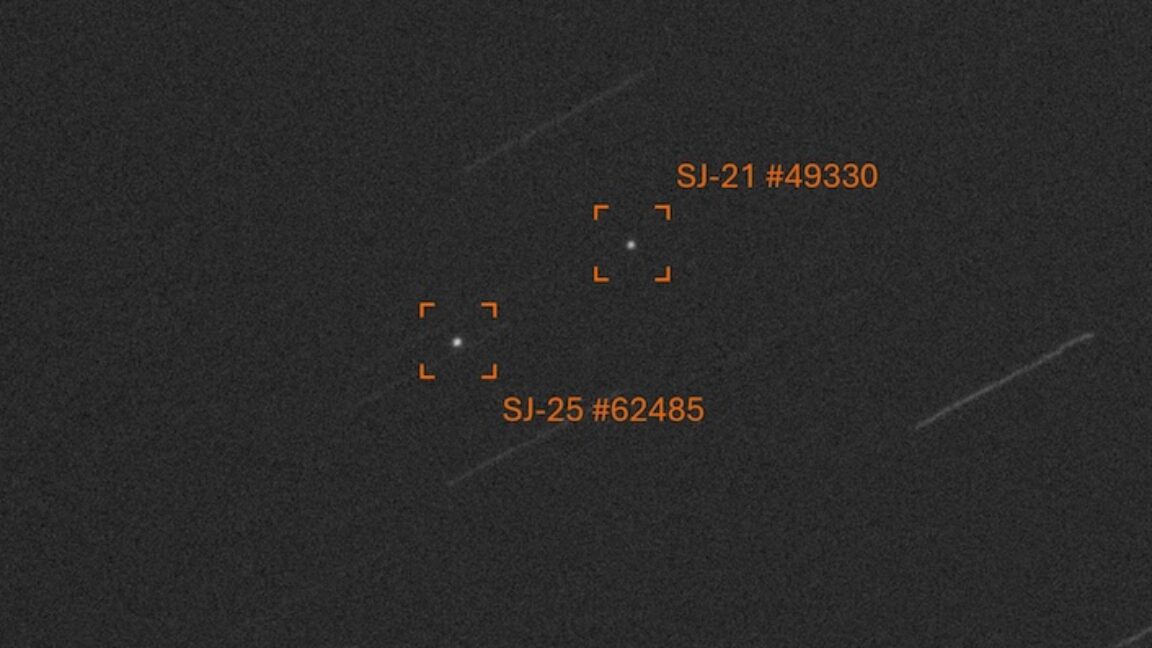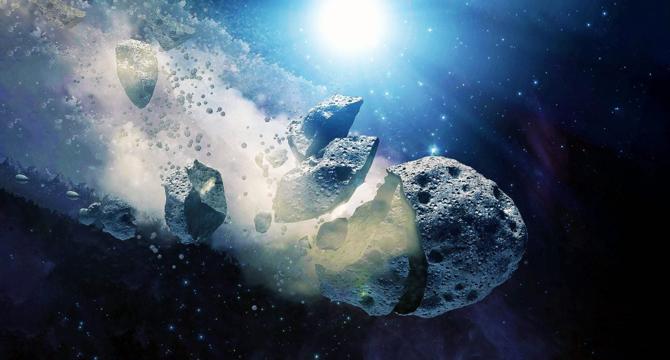Space News
Arstechnica
107

Image Credit: Arstechnica
Tuesday Telescope: Webb and Hubble team up to reveal spectacular star clusters
- Open star clusters are valuable for astronomers as they allow for the study of stars that formed around the same time, aiding in understanding stellar evolution.
- NASA has shared images of open star clusters in visible and infrared light captured by the Hubble and James Webb Space Telescopes, showcasing different aspects of the clusters.
- The Pleiades cluster and more distant clusters like NGC 460 and NGC 456 are highlighted in the images.
- The composite image created from overlapping observations from both telescopes reveals stunning details of the star clusters.
Read Full Article
6 Likes
Ars Technica
363

Image Credit: Ars Technica
China jumps ahead in the race to achieve a new kind of reuse in space
- Chinese satellites SJ-21 and SJ-25 rendezvoused in high-altitude space for refueling attempt.
- SJ-25 aims to verify satellite fuel replenishment tech while SJ-21 demonstrated space debris mitigation.
- US Space Force also explores orbital refueling. China's advancement poses potential challenges.
- Chinese positioning indicates emerging capabilities in space activities, raising international scrutiny.
Read Full Article
10 Likes
Earthsky
70

Image Credit: Earthsky
Earth could be in a void, Big Bang sound waves suggest
- Earth may be in a billion-light-year-wide void, explaining Hubble tension.
- Big Bang sound waves suggest this theory, affecting universe's expansion rate.
- Research proposes Earth's position in a void as a solution to Hubble discrepancy.
- Astronomers analyze baryon acoustic oscillations to support the idea of a local void.
Read Full Article
4 Likes
Earthsky
119

Image Credit: Earthsky
A deep-space navigation first, from New Horizons
- New Horizons spacecraft marks deep-space navigation first by imaging 2 stars in galaxy.
- Astronomers pinpoint spacecraft's location using star images; demonstrate interstellar navigation.
- First use of stars imaged from spacecraft for navigational fix on interstellar trajectory.
Read Full Article
7 Likes
Discover more
Hackaday
318

Image Credit: Hackaday
Touch Lamp Tracks ISS with Style
- Youthful Maker, Will Dana, creates an ISS-tracking lamp using an off-the-shelf globe and stepper motors configured for alt/az control.
- The lamp features an ESP32 for control, touch-activated LEDs, and a 3D printed ISS model that moves across the globe's surface.
- The ISS position is fetched using a NASA API, and the device resets every orbit due to lacking slip rings or a 360-degree stepper.
- The project showcases the young generation's talent in innovative DIY projects, with the lamp being a unique and creative creation.
Read Full Article
19 Likes
Earthsky
247

Image Credit: Earthsky
New clues to how galaxies sustain star formation
- Scientists found high-velocity gas clouds in galaxy Messier 83, likely from outside it.
- These dense molecular clouds may explain how galaxies sustain star formation over time.
- Research suggests galaxies can pull in gas from surroundings to fuel star formation.
- Galaxies like Messier 83 might accrete gas from intergalactic medium or nearby galaxies.
Read Full Article
14 Likes
Knowridge
309

Image Credit: Knowridge
Tiny space pebbles reveal the birth of new solar systems
- Astronomers using radio telescopes in the U.K. have discovered planet-forming pebbles orbiting two young stars, DG Tau and HL Tau.
- These pebbles, found in protoplanetary disks around the stars, are believed to be the building blocks of planets like Earth, Jupiter, and Saturn.
- This discovery sheds light on the early stages of planet formation, a crucial missing piece in understanding how solar systems develop.
- The research is part of the PEBBLeS project led by Professor Jane Greaves and offers insights into how solid material gathers in protoplanetary disks before planets form.
Read Full Article
18 Likes
TechnologyReview
41

Image Credit: TechnologyReview
Inside the most dangerous asteroid hunt ever
- Astronomers track 130- to 300-foot asteroid with 3.1% chance of 2032 Earth impact.
- Scientists contemplate various methods to prevent asteroid catastrophe, ultimately determining Earth impact unlikely.
- Observatories worldwide monitor asteroid's trajectory, refining calculations to low 0.3% impact probability.
- JWST observes asteroid, reveals it is 200 feet across, eliminating Earth threat but moon impact possible.
Read Full Article
2 Likes
Earthsky
190

Image Credit: Earthsky
Summer Triangle star: Vega is bright and blue-white
- The Summer Triangle consists of blue-white Vega, distant Deneb, and fast-spinning Altair.
- Vega, the brightest star in the East in July evenings, is blue-white and located in Lyra.
- Observing Vega and its constellation, Lyra, reveals interesting features and astronomical significance.
- Vega is a fast-spinning, middle-aged star with a unique asteroid belt detected around it.
Read Full Article
11 Likes
Spaceflightnow
194

Live coverage: SpaceX to launch 28 Starlink satellites on Falcon 9 rocket from Cape Canaveral
- SpaceX is set to launch 28 Starlink satellites on its Falcon 9 rocket from Cape Canaveral in a mission called Starlink 10-28.
- The launch is scheduled for 4:21 a.m. EDT from Space Launch Complex 40, with live coverage available prior to liftoff.
- Weather conditions are favorable with a 95 percent forecasted chance for clear skies, minimal interference from cumulus clouds.
- The mission will reuse the Falcon 9 first stage booster B1077 for the 22nd time, aiming for a droneship landing which would mark the 117th successful touchdown for the vessel and the 473rd booster landing for SpaceX.
Read Full Article
11 Likes
Knowridge
397

Image Credit: Knowridge
Scientists capture stunning image of a distant black hole jet
- Scientists have captured a detailed image of a powerful jet emanating from a distant black hole by connecting advanced radio telescopes worldwide.
- The collaboration involved telescopes from various countries, with South Africa's MeerKAT telescope teaming up with the European VLBI Network for the first time.
- MeerKAT's 64 dishes, when combined through VLBI, act like a single telescope spanning thousands of kilometers, enabling detailed observation of cosmic events.
- This breakthrough not only enhances the quality of images but also highlights the potential of future telescopes like the Square Kilometre Array (SKA) to delve deeper into the universe.
Read Full Article
15 Likes
Nasa
327

Image Credit: Nasa
Curiosity Blog, Sols 4589 – 4592: Setting up to explore Volcán Peña Blanca
- Curiosity Rover is exploring a feature named Volcán Peña Blanca on Mars, which includes a 3-foot high ridge with sedimentary structures indicating clues about rock deposition.
- Team planned a drive to approach the ridge for closer investigation, setting up for contact science activities on Monday.
- Additional activities were planned over the U.S. 4th of July holiday weekend, including investigating light-toned rocks and conducting instrument analyses.
- Curiosity will investigate rocks with instruments like APXS, MAHLI, and ChemCam, and conduct high-resolution imaging of various features in the area.
Read Full Article
19 Likes
Nasa
16

Image Credit: Nasa
Curiosity Blog, Sol 4588: Ridges and troughs
- On Sol 4587, NASA's Curiosity rover encountered different terrain features including more resistant ridges, rubbly areas, and trough-like features.
- The science team aims to analyze the composition and texture of rocks in these varied terrains, with a focus on understanding the differences between more resistant ridges and troughs.
- Planned activities involve brushing a target rock named 'Guapay', analyzing rocks with APXS and MAHLI, and capturing Mastcam images of the 'Volcan Pena Blanca' ridge.
- The rover will also conduct long-distance imaging with ChemCam, image the 'Mishe Mokwa' butte, and perform atmospheric observations before continuing towards Mount Sharp.
Read Full Article
Like
Brighter Side of News
20

Image Credit: Brighter Side of News
Space ice is less like water than scientists thought, study finds
- Water frozen in space was thought formless, but new study challenges this.
- Detailed simulations show tiny crystals within disordered space ice, changing previous beliefs.
- Findings have implications for understanding ice in the Universe and its role in cosmological processes.
Read Full Article
1 Like
Earthsky
157

Image Credit: Earthsky
Did something just hit Saturn? See the image here!
- Mario Rana captured a bright flash on Saturn at 5:07:56 a.m. EDT on July 5, 2025, suggesting a possible impact.
- A call for more observations has been made to confirm the event of the potential impact on Saturn.
- The solar system contains various debris, making impacts on planets like Saturn a rare but possible event.
- The impact of Comet Shoemaker-Levy 9 into Jupiter in 1994 showcased the potential for such events in our solar system.
Read Full Article
9 Likes
For uninterrupted reading, download the app